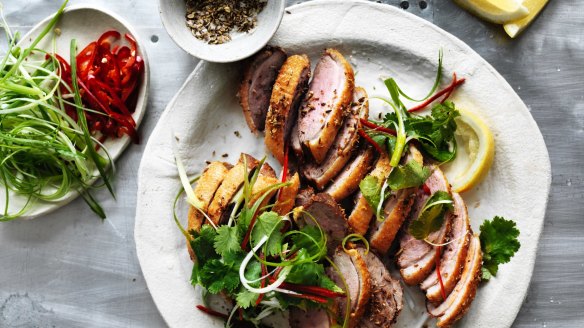Why is chicken breast meat white and duck breast red?

Why is chicken breast meat white and duck breast red? P. Keller
Ever seen a chicken fly? It's not a graceful spectacle, nor a long one. Chickens are originally birds that scratched and foraged about the forest floors of south-east Asia. They were small and scrawny, and never spent a great deal of time on the wing. The original ducks, however, did. They used to be migratory birds. Flying takes energy and that energy comes from recombining molecules of carbohydrate and oxygen in the muscles. Oxygen can come directly from the oxygen-carrying cells in blood or oxygen stored in muscles. Oxygen is stored in muscles in myoglobin – a protein. Muscles that tend to do a lot of work and need more oxygen contain more myoglobin and are darker. Duck breast has more myoglobin than chicken breasts and is therefore darker. Chook legs do more work than the breasts that power the wings, have more myoglobin than the breasts, and are therefore darker. Duck breasts will maintain a pink hue even when cooked through; this is not an indication of being underdone.
What is broiling? H. Handley
If you're in the US and see broiled fish on the menu it means the fish has been grilled, generally under a gas-powered "broiler". In Australian restaurant kitchens they are called salamanders. In domestic kitchens we refer to them as grills or grillers. The word broiler comes to American English from the French bruler or "to burn". You can see this in creme brulee, where the sugary top of the egg custard dessert is burned under a flame or a salamander. Or broiler. As kids, we always used our griller to make cheese on toast (tomato chutney under a layer of Kraft processed cheese on top of toasted slices of Sunny Crust bread). I like to use ours now to finish a piece of fish, skin on. To do this I cook fish skin side down in an ovenproof pan until the skin is crisp. I brush the flesh with a little oil, or rendered fat from the pan, and quickly grill close to the flame of the griller until the top of the fish is brown. This sees the top and bottom cooked through and the centre medium rare.
Can I forage the wood sorrel in the park? P. Crompton
OK. We're talking about the little ground cover with leaves like three-leafed shamrocks and cheery yellow flowers like buttercups. Also called sour grass, it is a plant with the botanic name oxalis. There are 30 different species of wood sorrel in Australia, seven of them native. Picking native plants on public land can be an offence that carries some serious fines. In Tasmania, even picking weeds in public nature reserves can carry a whopping fine. What makes oxalis sour is oxalic acid. It is fine to consume it in small amounts but eating too much oxalis can cause kidney stones. Some gardeners consider oxalis a pest and spray it with poison. Most councils add dye to weed killer when they spray in public places. So there are a few things to consider before you head to the park with a wicker basket.
Send your vexing culinary conundrums to brainfood@richardcornish.com.au or tweet or insta @foodcornish
- More:
- Food
- Brain food
